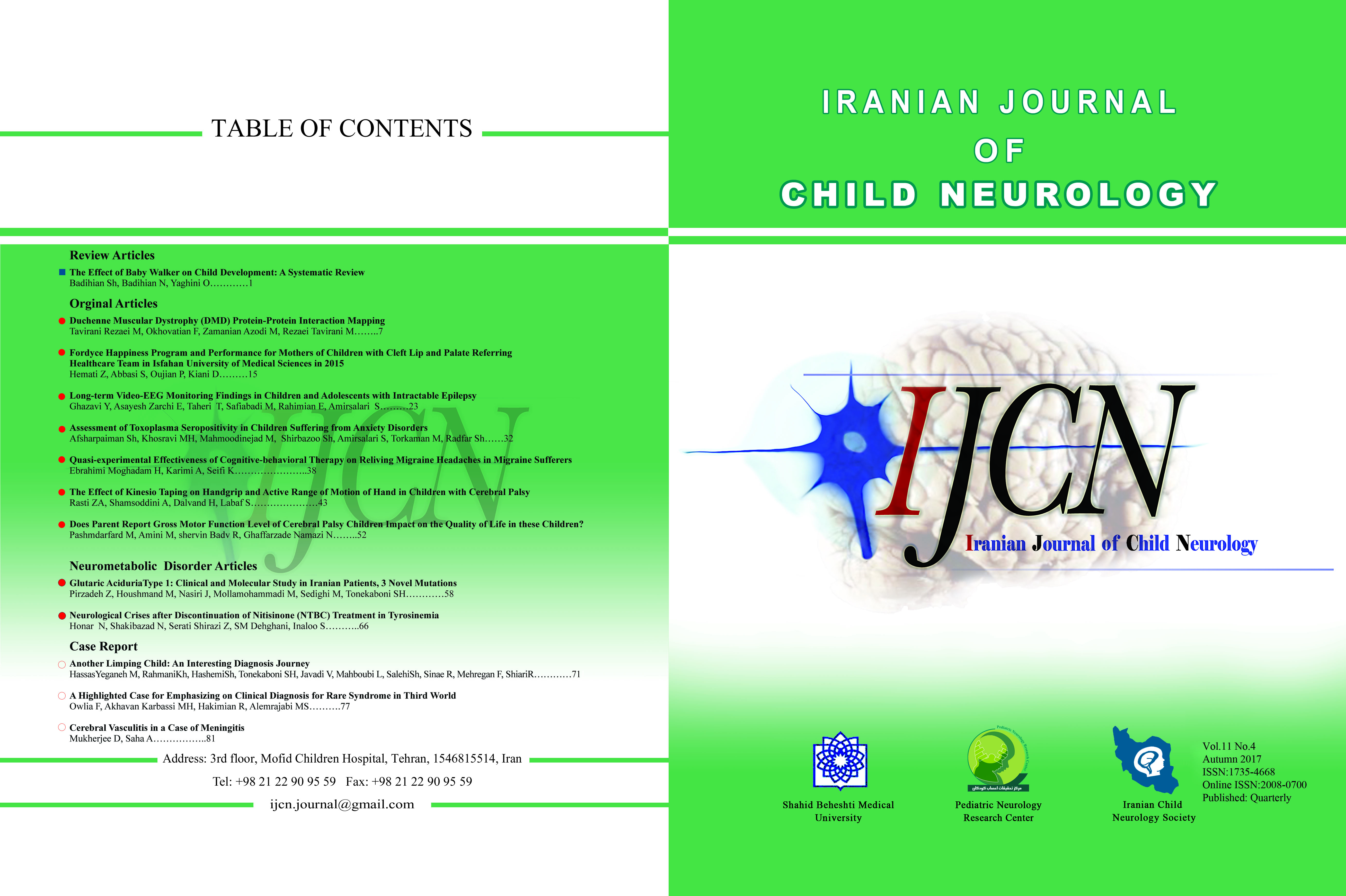Assessment of Toxoplasma seropositivity in low Toxoplasma seroprevalence children suffering from anxiety disorders
Iranian Journal of Child Neurology,
Vol. 11 No. 4 (2017),
13 Shahrivar 2017
,
Page 32-37
https://doi.org/10.22037/ijcn.v11i4.10313
Abstract
Objective:
To assess seroprevalence of Toxoplasma gondii in children with anxiety disorders
Materials & methods:
This case-control study was conducted between September 2012 and May 2013 in pediatrics clinic of Baqiyatallah hospital. Children referred to child psychiatry clinic of our hospital were selected to be assessed clinically. Diagnosis of patients with anxiety disorders was based on DSM-4system, which is performed by child psychiatrist. Then they were referred to laboratory in order to have their anti-toxoplasma antibodies measured. A questionnaire was verbally administered to all individuals’ parents including demographic information and questions about life style, family history, medical history, economic situation, residence, nutritional patterns and contact with animals.
Result:
Ninety-six male and female cases with a mean age of 8.56±2.5 and 8.42±1.9 underwent analysis. Anti-T.gondii IgG antibody was found in one case of each group There was no significant difference between case and control groups for serum Toxoplasma IgG antibody (p=0.14). No case individuals had Anti-T.gondii IgM antibody, while it was found in one control individual. No significant difference was seen between case and control groups for Toxoplasma IgM antibody (p=0.27).
Conclusion:
In conclusion, our findings suggest that toxoplasmosis has no direct effect on the incidence of anxiety disorders. More studies are needed with a larger volume of individuals in future.- Anxiety disorders
- Toxoplasmosis
- Toxoplasma gondii
- Children
- Antibodies
How to Cite
References
Hay, J., Hutchison, W. M., Aitken, P. P., & Graham, D. I. (1983). The effect of congenital and adult-acquired Toxoplasma infections on activity and responsiveness to novel stimulation in mice. Annals of tropical medicine and parasitology, 77(5), 483-495.
Sims, T. A., & Hay, J. (1995). Host-parasite relationship between congenital Toxoplasma infection and mouse brain: role of small vessels. Parasitology, 110(02), 123-127.
Hodková, H., Kolbeková, P., Skallová, A., Lindová, J., & Flegr, J. (2007). Higher perceived dominance in Toxoplasma infected men--a new evidence for role of increased level of testosterone in toxoplasmosis-associated changes in human behavior. Neuroendocrinology Letters, 28(2), 110-114.
Brain, Y. (1985). i Changes in brain concentrations of catecholamines and indoleamines in Toxoplasma gondii infected mice,-. Annals of tropical medicine and parasitology, 79(2), 153-157.
Treuer, T., Martenyi, F., & Karagianis, J. (2007). Parasitosis, dopaminergic modulation and metabolic disturbances in schizophrenia: evolution of a hypothesis. Neuro endocrinology letters, 28(5), 535-540.
Yuksel, P., Alpay, N., Babur, C., Bayar, R., Saribas, S., Karakose, A. R., ... & Kocazeybek, B. (2010). The role of latent toxoplasmosis in the aetiopathogenesis of schizophrenia–the risk factor or an indication of a contact with cat. Folia Parasitol, 57, 121-128.
Pauls DL, Alsobrook JPII, Goodman, W, Rasmussen, S, Leckman, JF. 1995. A family study of obsessive compulsive disorder. Am J Psychiatry 152: 76–84.
Smadja, D., Cabre, P., Prat, C., & Vernant, J. C. (1995). [Loss of psychic auto-activation. Obsessive-compulsive behavior. Toxoplasmic abscess of the basal ganglia]. Revue neurologique, 151(4), 271-273.
Piekarski, G. (1981). Behavioral alterations caused by parasitic infection in case of latent toxoplasma infection. Zentralblatt für Bakteriologie, Mikrobiologie und Hygiene. 1. Abt. Originale. A, Medizinische Mikrobiologie, Infektionskrankheiten und Parasitologie, 250(3), 403-406.
Yagmur, F., Yazar, S., Temel, H. O., & Cavusoglu, M. (2010). May Toxoplasma gondii increase suicide attempt-preliminary results in Turkish subjects?. Forensic science international, 199(1), 15-17.
Schiebe J, Henne K (1983) Patho- genetische Varianz
und diagnostische Kriterien der Neurotoxoplasmose. Psy- chiat Neurol Med Psychol 35:
–221
Brynska, A., Tomaszewicz-Libudzic, E., & Wolanczyk, T. (2001). Obsessive-compulsive disorder and acquired toxoplasmosis in two children. European child & adolescent psychiatry, 10(3), 200-204.
Torrey, E. F., & Yolken, R. H. (2003). Toxoplasma gondii and schizophrenia. Emerging infectious diseases, 9(11), 1375.
Alvarado-Esquivel, C., Urbina-Álvarez, J. D., Estrada-Martínez, S., Torres-Castorena, A., Molotla-de-León, G., Liesenfeld, O., & Dubey, J. P. (2011). Toxoplasma gondiiinfection and schizophrenia: A case control study in a low Toxoplasmas eroprevalence Mexican population. Parasitology international, 60(2), 151-155.
Perez, M., Brown, J. S., Vrshek-Schallhorn, S., Johnson, F., & Joiner Jr, T. E. (2006). Differentiation of obsessive-compulsive-, panic-, obsessive-compulsive personality-, and non-disordered individuals by variation in the promoter region of the serotonin transporter gene. Journal of anxiety disorders, 20(6), 794-806.
Luu, T. M., Ment, L. R., Schneider, K. C., Katz, K. H., Allan, W. C., & Vohr, B. R. (2009). Lasting effects of preterm birth and neonatal brain hemorrhage at 12 years of age. Pediatrics, 123(3), 1037-1044.
Elgen, I., Sommerfelt, K., & Markestad, T. (2002). Population based, controlled study of behavioural problems and psychiatric disorders in low birthweight children at 11 years of age. Archives of Disease in Childhood-Fetal and Neonatal Edition, 87(2), F128-F132.
Abdoli, A., & Dalimi, A. (2014). Are there any relationships between latent Toxoplasma gondii infection, testosterone elevation, and risk of autism spectrum disorder?. Frontiers in behavioral neuroscience, 8.
Mufaddel, A., Omer, A. A., & Salem, M. O. (2014). Psychiatric Aspects of Infectious Diseases. Open Journal of Psychiatry, 2014.
Markovitz, A. A., Simanek, A. M., Yolken, R. H., Galea, S., Koenen, K. C., Chen, S., & Aiello, A. E. (2015). Toxoplasma gondii and anxiety disorders in a community-based sample. Brain, behavior, and immunity, 43, 192-197.
- Abstract Viewed: 413 times
